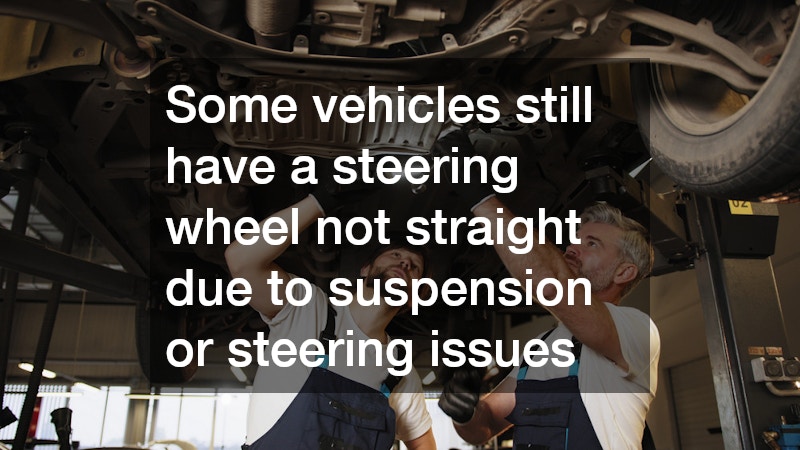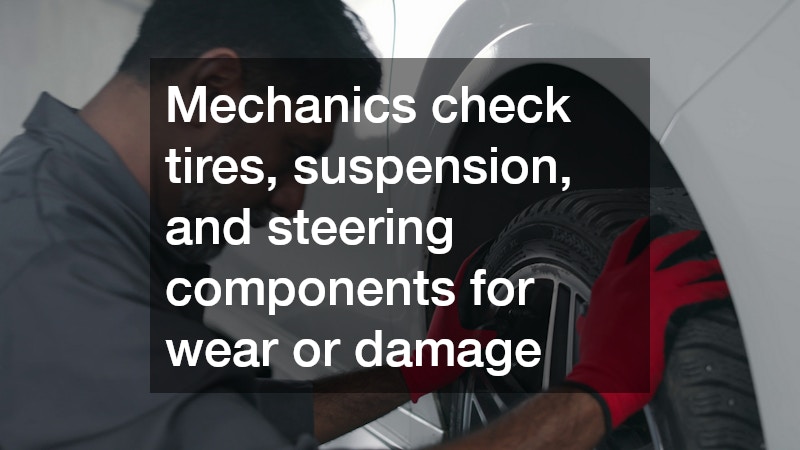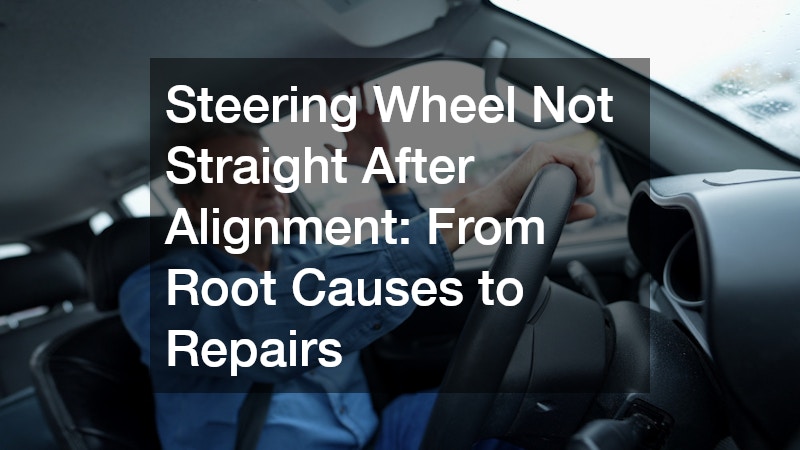- A crooked or off-center steering wheel after alignment can indicate underlying suspension, steering, or frame issues, not just a cosmetic problem.
- Common causes include incorrect alignment settings, worn suspension components, steering system wear, uneven tire wear, and past accidents.
- Proper wheel alignment involves adjusting camber, caster, and toe, but even a correct alignment can leave the steering wheel off-center if other issues exist.
- Driving with a misaligned or off-center steering wheel can reduce vehicle stability, increase tire wear, and compromise safety during emergency maneuvers.
- Diagnosis should include test drives, tire inspections, suspension and steering checks, professional alignment measurements, and frame inspections if needed.
- Repairs may range from simple wheel alignment and tire adjustments to suspension or steering component replacements, and even frame straightening in severe cases.
- Regular maintenance, tire rotations, steering inspections, and avoiding rough roads can help prevent steering wheel misalignment and prolong vehicle safety.
If you’ve recently had your vehicle’s wheels aligned but notice that your steering wheel isn’t straight, you’re not alone. This is a common frustration among car owners and can be more than just a cosmetic issue. A crooked steering wheel can affect your driving comfort, vehicle handling, and even safety. In this guide, we’ll walk you through the main causes, potential risks, and practical repairs you can consider to get your steering wheel back to center.
Why Is My Steering Wheel Not Straight After Alignment?

A properly aligned vehicle should have the steering wheel centered when driving straight. However, even after an alignment, some vehicles still have a steering wheel not straight due to suspension or steering issues. Some of the most common causes include:
- Incorrect alignment settings: Sometimes the alignment is technically within specification, but the steering wheel isn’t centered.
- Suspension issues: Worn or damaged components can shift wheel angles, affecting the steering position.
- Steering system wear: Problems in the steering column, tie rods, or rack and pinion can cause the wheel to sit off-center.
- Previous accidents: Structural or frame damage can lead to persistent misalignment that simple wheel alignment can’t fix.
Understanding the root cause is crucial before attempting any repair.
How Do Mechanics Align a Steering Wheel?
Wheel alignment isn’t just about adjusting your tires. It involves precise measurement and adjustment of multiple angles to ensure proper contact with the road. Here’s a simplified breakdown:
- Camber: The tilt of the wheels inward or outward when viewed from the front.
- Caster: The angle of the steering pivot that affects directional stability.
- Toe: How much the front of the wheels point inward or outward.
During an alignment, mechanics adjust these angles to factory specifications. However, if the steering wheel is still off-center afterward, the issue may be deeper than a simple alignment.
Common Causes of a Crooked Steering Wheel After Alignment
Even with a perfect alignment, several factors can prevent your steering wheel from sitting straight:
1. Uneven Tire Wear
Worn tires can create uneven resistance, making the steering wheel pull to one side. Inspect your tires for:
- Bald spots or uneven tread patterns
- Mismatched tire sizes or brands
- Incorrect tire pressure
2. Suspension Component Wear
A worn suspension can lead to subtle shifts in wheel position. Key components to check include:
- Ball joints
- Control arms
- Bushings
- Shock absorbers and struts
3. Steering Rack or Column Issues
A faulty steering rack or column can prevent the wheel from returning to its centered position. Symptoms may include:
- Loose or “sloppy” steering feel
- Clunking noises when turning
- Uneven steering response
4. Frame or Chassis Damage
If your vehicle has been in an accident, even minor frame damage can affect wheel alignment. This can lead to:
- Persistent off-center steering wheel
- Pulling to one side despite new alignment
- Irregular tire wear
5. Incorrect Alignment Procedure
Even skilled mechanics can sometimes make minor errors, especially if they don’t reset the steering wheel before adjusting angles. If the wheel wasn’t centered during the alignment, it may remain crooked afterward.
How Dangerous Is Driving With a Crooked Steering Wheel?
While a slightly off-center steering wheel may not immediately affect safety, it can indicate underlying issues that compromise your vehicle’s handling. Risks include:
- Reduced vehicle stability
- Increased tire wear
- Steering system damage over time
- Poor handling during emergency maneuvers
How Can You Diagnose the Issue?
Diagnosing the root cause is the first step toward a lasting repair. Here’s how you can approach it:
- Test drive: Observe if the vehicle pulls to one side or if the steering feels uneven.
- Check tires: Inspect for uneven wear or incorrect tire pressure.
- Visual suspension inspection: Look for worn bushings, ball joints, or control arms.
- Professional alignment check: Have a certified mechanic re-measure the alignment angles.
- Frame inspection: If there’s a history of accidents, consider a chassis check.
DIY Fixes vs Professional Repairs
Some issues can be addressed at home, while others require professional intervention. Here’s a breakdown:
DIY Checks
- Rotate and balance tires to even out wear
- Adjust tire pressures to recommended levels
- Ensure the steering wheel is centered before attempting minor alignment tweaks
Professional Repairs
- Full wheel alignment with steering wheel centering
- Replacement of worn suspension components
- Steering rack or column repairs
- Frame straightening for vehicles with structural damage
Step-by-Step: How Mechanics Fix a Crooked Steering Wheel After Alignment

Here’s what typically happens during a professional repair:
- Inspection: Mechanics check tires, suspension, and steering components for wear or damage.
- Test alignment: The car is placed on an alignment rack, and angles are measured.
- Adjust angles: Toe, camber, and caster are adjusted to factory specifications.
- Center steering wheel: The steering wheel is aligned with the wheels’ straight-ahead position.
- Test drive: The car is driven to ensure proper handling and wheel centering.
- Recheck alignment: Final adjustments are made if needed.
How Much Does It Cost to Fix a Steering Wheel That’s Off-Center?
Repair costs vary depending on the underlying cause:
- Wheel alignment only: $80–$150 AUD
- Suspension component replacement: $200–$800 AUD
- Steering rack replacement: $600–$2,000 AUD
- Frame repair: $1,000–$5,000+ AUD
Getting an accurate diagnosis first can prevent unnecessary expenses.
Tips for Preventing Steering Wheel Misalignment
Prevention is always better than cure. Consider these tips:
- Rotate tires every 10,000 km to prevent uneven wear
- Inspect suspension and steering components regularly
- Avoid potholes and rough terrain when possible
- Schedule wheel alignments after any suspension work or accident
- Check tire pressures monthly
When to Seek Immediate Help
Certain signs indicate you shouldn’t wait to fix your off-center steering wheel:
- Steering wheel is extremely crooked
- Car pulls hard to one side
- Unusual noises when turning
- Steering feels loose or unresponsive
Ignoring these symptoms can lead to increased wear, safety risks, and expensive repairs down the line.
Wrapping Up
A steering wheel that’s not straight after alignment is more than a minor inconvenience—it can be a signal of underlying issues that affect safety, handling, and tire longevity. By understanding the potential causes, performing regular inspections, and seeking professional repairs when needed, you can keep your vehicle driving straight and smooth. Whether it’s a simple alignment tweak or a more involved suspension or steering repair, addressing the problem early will save you time, money, and stress on the road.
